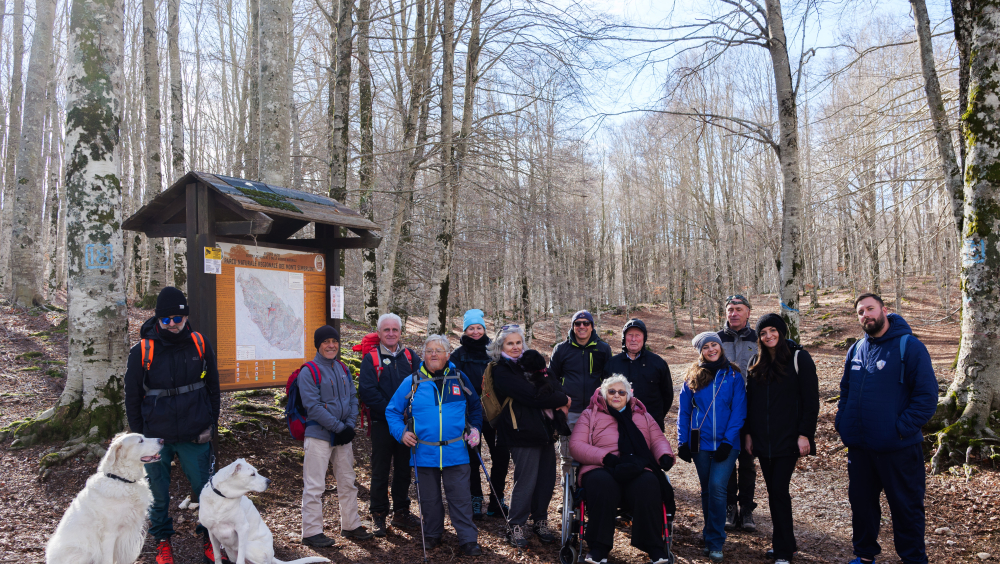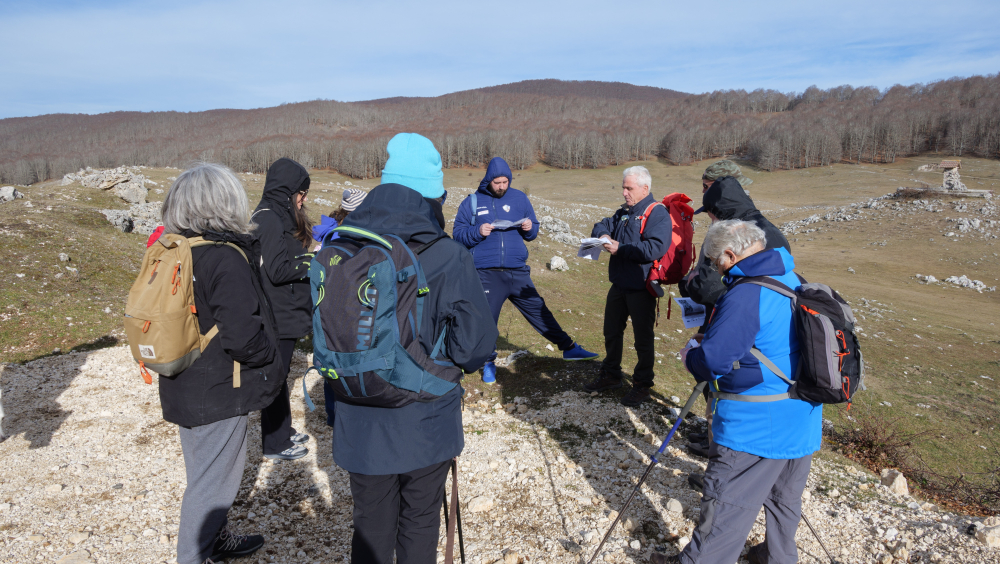Walking ancient trails in the footsteps of the transhumants
Walking along the ancient transhumant routes offers the opportunity to discover places, local communities and their traditions, cultural and natural core areas, memory and narrative. These routes have been the lever and the vehicle for the common cultural values and the European identity.
On Saturday 23rd, December 2023 the Italian headquarter dedicated to the Cultural Route of the Council of Europe «Transhumance Trails», certified in 2023, was inaugurated in Jenne, a small village in the Apennines in Central Italy, NE of Roma, where one of the most well-known local sheep and goat transhumance route, known as «Tratturo Jenne-Anzio» once started and still starts.
A ceremony was organised for an enthusiastic public, enjoying this unexpected, welcomed resurrection of memories and dignity of the local identity.
During the morning, a guided excursion to locations scattered along the upper part of the trail was guided, while in the afternoon a conference presenting the newly certificated Route and contributions dealing with the origin and history of the trail, was organised by the Scientific Committee of the «Transhumance Trails».
The morning field-trip reached Piana di Fondi di Jenne, a mountain plateau upslope at 1.400 meter a.s.l., which has been, from time immemorial, the gathering place for shepherds and their herds before starting their annual migration in early autumn from the summits of Monti Simbruini towards the coastal plains of the Tyrrhenian Sea south of Rome.
Here the transhumants would spend the winter, grazing their herds on the lush marshlands close to the sea. As summer approaches, and these winter-green pastures begin to dry out, humans and animals would leave the lowlands, starting their journey back upslope to the summer pasturelands on the fresh meadows of the highlands above the tree-line.
The shepherd Innocenzo, already in his eighty, shared with us the memory of the great excitement experienced by the shepherds, when, in the beginning of summer they returned to Fondi, and the plain echoed the calls of men and the voices of animals, celebrating the end of winter.
They always brought back something, from the habits of the maritime communities. New skills, good deals, products and cultural exchanges. The community of Jenne achieved a very unusual delicacy for mountain people: pickled anchovies.
These anchovies have become the basic ingredient of a local traditional beloved dish called «’ndremmappi». Nobody knows exactly where this word comes from. Yet, even children in Jenne know what it is. A local type of oblong lumps wholemeal dough, seasoned with tomato sauce with fried garlic and anchovies, topped with shredded pecorino cheese. Mountain pastoral and seaside tastes, melt in this home dish of the local shepherds. A tasty paradigm of a long lasting cultural exchange.
Learning from this brilliant contamination, we developed a “format” to shape our guided excursions in order to facilitate the access to the experience of walking the trails for different ranks of people, in the most inclusive way.
By means of this format, the activities carried out in each country member to promote the «Transhumance Trails» will share the common branding of the Route.
The experience of walking a transhumance track not only aims to offer outdoor recreation, but also to provide visitors with the right clue to approach and discover the local environmental, historical, traditional context. In this framework at the end of any excursion, we always organise the tasting of the local gastronomy. «’Ndremappi» is culture as much as vernacular music, storytelling or any other traditional local produce.
The field trip during the inauguration day in December 2023, thanks to the mild weather, quite unusual for the winter season of the district, allowed us to test the inclusivity of the track. One of the most courageous visitors was a lady in a wheelchair, counsellor and honour member of the Route, who helped us to figure out how to perform an inclusive and disabled friendly access to the experience of the pastoral nomadic life.
In the following afternoon, the Inauguration Conference was very crowded, considering that Jenne is located in the mountain region of Monti Simbruini, some 90 kilometres far away from Rome. The success of the initiative undoubtedly relied upon the great expectations of the local community.
In fact, from the very beginning of the project, we envisioned the headquarter of the «Transhumance Trails» as a cultural hub for the village of Jenne and for the surrounding district, still very rich in roaming livestock, memories, rural knowledge and consciousness.
Representatives of the local grassroot associations, were previously involved in order to share common goals of intercultural dialogue, cultural exchange, inclusivity, and to actively cooperate in the development of this hub.
The cooperation gave immediate results. Each active participant contributed with his own skill to settle the headquarter ready for the ceremony day.
The conference encompassed contributions from scholars and researchers from at least three different European countries, thus connecting the local context to the larger European one, maximising the intercultural approach, while focusing on the topic of walking the trails and trail-based cultural tourism.
The integrated model of managing the newly established headquarter as a shared cultural hub, is paying off. In cooperation with the Municipality and the local Association LUPA, «Transhumance Trails» joined the organisation of a pilot project for a summer camp of higher educational exchange programme for European students in the framework of the Erasmus BIP projects. The project will be carried out in partnership with the Academy of Fine Arts of Rome and the Municipality of Jenne, and in cooperation with Universities and Fine Arts Academies from Greece, Italy, Romania and Spain.
The Cultural Routes Programme of the Council of Europe pursues the ultimate goal of making explicit the common identity value of the cultural heritage of European countries.
Task of the Cultural Routes is then, to construct these journeys in space and time, in which intercultural dialogue, mutual exchange and enrichment, and the crossing of borders are realised.
It seemed to us that the «Transhumance Trails» were the perfect embodiment of the above, by virtue of the pan-European and transnational nature of the phenomenon of transhumance, of which we find traces and testimonies everywhere in Europe, from the Mediterranean to the Baltic and from the Atlantic coast to the Black Sea, as well as the significant physical heritage of the routes, which lend themselves so well to being retraced.

